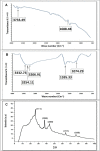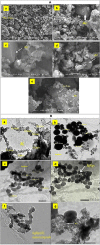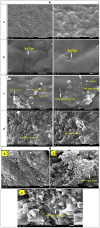Desalination of seawater using integrated microbial biofilm/cellulose acetate membrane and silver NPs/activated carbon nanocomposite in a continuous mode
- PMID: 38168504
- PMCID: PMC10762133
- DOI: 10.1038/s41598-023-50311-0
Desalination of seawater using integrated microbial biofilm/cellulose acetate membrane and silver NPs/activated carbon nanocomposite in a continuous mode
Abstract
The main objective of the present study was to desalinate seawater using Bacillus cereus gravel biofilm and cellulose acetate (CA) membranes with and without silver nanoparticles (AgNPs) as a potent and safe disinfectant for the treated water. Six desalination trials (I, II, III, IV, V and VI) were performed using the proposed biofilm/cellulose membrane. Results confirmed that Bacillus cereus gravel biofilm (microbial desalination) is the optimal system for desalination of seawater. It could achieve 45.0% RE (initial salinity: 44,478 mg/L), after only 3 h compared to the other tested treatments. It could also achieve 42, 42, 57, 43 and 59% RE for TDS, EC, TSS, COD and BOD, respectively. To overcome the problem of the residual salinity and reach complete elimination of salt content for potential reuse, multiple units of the proposed biofilm can be used in sequence. As a general conclusion, the Bacillus cereus biofilm system can be considered as remarkably efficient, feasible, rapid, clean, renewable, durable, environmentally friendly and easily applied technology compared to the very costly and complicated common desalination technologies. Up to our knowledge, this is the first time microbial biofilm was developed and used as an effective system for seawater desalination.
© 2024. The Author(s).
Conflict of interest statement
The authors declare no competing interests.
Figures






Similar articles
-
Application of nanosilver surface modification to RO membrane and spacer for mitigating biofouling in seawater desalination.Water Res. 2009 Aug;43(15):3777-86. doi: 10.1016/j.watres.2009.06.002. Epub 2009 Jun 6. Water Res. 2009. PMID: 19586651
-
Emerging desalination technologies for water treatment: a critical review.Water Res. 2015 May 15;75:164-87. doi: 10.1016/j.watres.2015.02.032. Epub 2015 Feb 26. Water Res. 2015. PMID: 25770440 Review.
-
Use of a liter-scale microbial desalination cell as a platform to study bioelectrochemical desalination with salt solution or artificial seawater.Environ Sci Technol. 2011 May 15;45(10):4652-7. doi: 10.1021/es200127p. Epub 2011 Apr 28. Environ Sci Technol. 2011. PMID: 21526816
-
Photovoltaic-Driven Battery Deionization System for Efficient and Sustainable Seawater Desalination.Environ Sci Technol. 2024 Dec 31;58(52):22992-23003. doi: 10.1021/acs.est.4c11467. Epub 2024 Dec 19. Environ Sci Technol. 2024. PMID: 39698896
-
A state-of-the-art review on microbial desalination cells.Chemosphere. 2022 Feb;288(Pt 1):132386. doi: 10.1016/j.chemosphere.2021.132386. Epub 2021 Oct 1. Chemosphere. 2022. PMID: 34606888 Review.
References
-
- Jia X, Klemeš JJ, Alwi SRW, Varbanov PS. Regional water resources assessment using water scarcity pinch analysis. Resour. Conserv. Recycl. 2020;157:104749. doi: 10.1016/j.resconrec.2020.104749. - DOI
-
- Weerasinghe, I. Water resource management. TORUS 3–Toward an Open Resour. Using Serv. Cloud Comput. Environ. Data 177–189 (2020). 10.1186/s12866-022-02652-5.
-
- Khilchevskyi, V. & Karamushka, V. Global water resources: Distribution and demand BT—clean water and sanitation. In (eds. Leal Filho, W. et al.) 1–11 (Springer International Publishing, 2020) 10.1007/978-3-319-70061-8_101-1.
-
- Tarhule, A. Part 4—The Future of Water: Prospects and Challenges for Water Management in the 21st Century. In (eds. Ziolkowska, J. R. & Peterson, J. M. B. T.-C. for W. R.) 442–454 (Elsevier, 2017). 10.1016/B978-0-12-803237-4.00025-2.
MeSH terms
Substances
LinkOut - more resources
Full Text Sources
Research Materials

